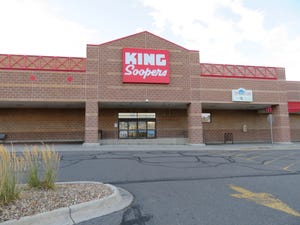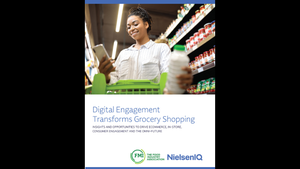Amazon reports Q3 dip in physical store salesAmazon reports Q3 dip in physical store sales
Robust online sales growth lessens cost impact of free one-day shipping
October 25, 2019
Sales at physical stores dipped for Amazon.com Inc. in the fiscal 2019 third quarter as the e-tail giant upheld strong growth in online retail and overall company sales.
For the quarter ended Sept. 30, physical store sales totaled $4.19 billion, down 1% from $4.25 billion a year earlier, Amazon reported yesterday after the market close. On a sequential basis, physical-store sales decreased 3.2% from $4.33 billion in the second quarter, when sales rose 1% year over year.
Amazon’s online store sales, meanwhile, jumped 21% at $35.04 billion from $29.06 billion a year ago. Excluding the impact of foreign exchange, the year-over-year growth was 22%, the company said.
Amazon’s physical-store sales come primarily from its Whole Foods Market unit and exclude online orders made via its brick-and-mortar brands, such as Prime Now delivery and pickup through Whole Foods stores.
Currently, Amazon’s U.S. physical stores include 484 Whole Foods Markets (505 including Canada and the United Kingdom), 16 Amazon Go convenience stores, 19 Amazon Books stores, five Amazon 4-Star outlets and four Presented by Amazon locations. The Seattle-based company doesn’t break out sales totals for its brick-and-mortar retail segments.
Overall, Amazon saw third-quarter net sales surge 24% to $69.98 billion from $56.58 billion in the 2018 quarter. Excluding a $500 million unfavorable impact from year-over-year changes in foreign exchange rates, net sales climbed 25% in the 2019 quarter, the company said.
Operating income fell 15.2% to $3.16 billion in the third quarter from $3.72 billion in the prior-year period. Net earnings declined to $2.13 billion, or $4.23 per diluted share, from $2.88 billion, or $5.75 per diluted share, a year earlier.
On average, analysts had projected net earnings per share of $4.62, with estimates ranging from a low of $3.35 to a high of $6.03, according to Refinitiv/Thomson Reuters.
“We are ramping up to make our 25th holiday season the best ever for Prime customers, with millions of products available for free one-day delivery,” founder and CEO Jeff Bezos (below) said in a statement. “Customers love the transition of Prime from two days to one day; they’ve already ordered billions of items with free one-day delivery this year. It’s a big investment, and it’s the right long-term decision for customers.

“Although it’s counterintuitive, the fastest delivery speeds generate the least carbon emissions because these products ship from fulfillment centers very close to the customer,” Bezos added. “It simply becomes impractical to use air or long ground routes. Huge thanks to all the teams helping deliver for customers this holiday.”
In a conference call with analysts late Thursday, Chief Financial Officer Brian Olsavsky shed more light on the impact of free Prime one-day shipping on operating and bottom-line results.
“Back in Q2, I said that we were estimating an $800 million expense tied to one-day in Q2, and we actually were just above that in Q2. In Q3, we expected that to grow. We've put it into our guidance, and we hit essentially where we expect it on the guidance. So, as we head into Q4, we've added what's just nearly $1.5 billion penalty in Q4 year over year for the cost of shipping, which is essentially transportation costs,” Olsavsky (below) said, citing expansion of transportation capacity and forward-deploying inventory closer to customers.

“By and away the biggest expense is on the actual transportation cost. So we've built that into our Q4 guidance estimate,” he explained. “But we're very pleased with the customer response to one-day. You can see it in our revenue acceleration and also in our unit growth acceleration. Once again, the ops team has really done yeoman's work here to create this capacity for us, and they continue to unlock additional capacity daily. We're expecting that it will be again a great help to customers in Q4. We have seen Prime members increase their orders, spend more. So they must also see it as a real help to them in their daily lives.”
For the 2019 fourth quarter, Amazon forecasts net sales of $80 billion to $86.5 billion, which would represent year-over-year growth of 11% and 20% (including an 80-basis-point negative impact from foreign exchange rates). Operating income is pegged at $1.2 billion to $2.9 billion, compared with $3.8 billion in the 2018 fourth quarter.
“Amazon reported a 2% sales beat ($69.9 billion versus $68.8 billion consensus), representing 24% year-over-year growth (25% excluding FX), as one-day shipping appears to continue benefiting the top line, with online sales ( 21% year over year) accelerating to its fastest organic growth rate in two years,” Jefferies analyst Brent Thill said in a research note late yesterday. “Q3 operating income was at the high end of guidance and exceeded consensus estimates ($3.12 billion versus $2.94 billion), driven by lower-than-expected losses in the international segment.”
The fourth-quarter outlook from Amazon was weak, Thill said, and the retailer saw its share price decline after releasing its guidance.
“Amazon expects Q4 net sales to be between $80 billion and $86.5 billion (year-over-year growth of 11% to 20%), representing 1% downside to consensus at the high end. Operating income is expected to be between $1.2 billion and $2.9 billion, below consensus (31% below consensus at the high end), driven by near-term investments behind one-day shipping and headcount,” he said, adding, “Amazon typically takes a pragmatic approach to its profit outlook.”
About the Author
You May Also Like






